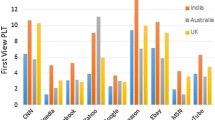Abstract
Web caching is used to solve the problem of network access delays and network congestion. The intelligent cache replacement strategy directly affects the cache hit rate. This paper proposed a web cache replacement strategy combining greedy dual size frequency (GDSF) algorithm and support vector machine (SVM) re-accessed probability prediction. In the traditional GDSF method, a new objective function is constructed by considering the network object type and object re-accessed probability. The object re-accessed probability is predicted by learning the historical access data through SVM classifier. The simulation results show that compared with the traditional LRU and GDSF schemes, the proposed strategy has a higher request hit rate and byte hit ratio. When the cache size is 16%, the HR and BHR values reached 0.623 and 0.522, respectively.




Similar content being viewed by others
Explore related subjects
Discover the latest articles and news from researchers in related subjects, suggested using machine learning.References
Aimtongkham P, So-In C, Sanguanpong S (2016) A novel web caching scheme using hybrid least frequently used and support vector machine [C]. In: International joint conference on computer science and software engineering. IEEE, pp 1–6
Ali W, Shamsuddin SM, Ismail AS (2011) Intelligent web proxy caching approaches based on support vector machine [C]. In: International conference on informatics engineering and information science. Springer, Berlin, pp 559–572
Ali F, Khan P, Riaz K et al (2017) A fuzzy ontology and SVM-based web content classification system [J]. IEEE Access 24(5):25781–25797
Arora H, Bhatia U, Pandita S (2015) Comparative study of different cache models on SimpleScalar architecture [C]. In: Communication and computing. IET, pp 302–304
Banditwattanawong T (2012) From web cache to cloud cache [C]. In: International conference on grid and pervasive computing. Springer, Berlin, pp 1–15
Ergul E, Arica N, Ahuja N et al (2016) Clustering through hybrid network architecture with support vectors [J]. IEEE Trans Neural Netw Learn Syst 28(6):1373–1385
Hao Y, Ma T, Shen W et al (2018) An improved web cache replacement algorithm based on weighting and cost [J]. IEEE Access 25(6):1352–1360
Islam MMM, Kim JM (2017) Time–frequency envelope analysis-based sub-band selection and probabilistic support vector machines for multi-fault diagnosis of low-speed bearings [J]. J Ambient Intell Humaniz Comput 8(1):1–16
Kumar PNV (2014) Novel web proxy cache replacement algorithms using machine learning, techniques for performance enhancement [J]. Int J Eng Sci Res Technol 3(1):339–346
Ma T, Qu J, Shen W et al (2018) Weighted greedy dual size frequency based caching replacement algorithm [J]. IEEE Access 25(6):7214–7223
Olanrewaju RF, Al-Qudah DMM, Azman AW et al (2016) Intelligent web proxy cache replacement algorithm based on adaptive weight ranking policy via dynamic aging [J]. Indian J Sci Technol 9(36):142–148
Romano S, Elaarag H (2011) A neural network proxy cache replacement strategy and its implementation in the Squid proxy server [J]. Neural Comput Appl 20(1):59–78
Sajeev GP, Sebastian MP (2011) Comparing the performance of multinomial logistic regression and neural network models in web cache content classification [C]. In: Icmlc 2011: the, international conference on machine learning and computing, pp 53–58
Sheu JP, Chuo YC (2016) Wildcard rules caching and cache replacement algorithms in software-defined networking [J]. IEEE Trans Netw Serv Manag 13(1):19–29
Songwattana A, Theeramunkong T, Vinh PC (2014) A learning-based approach for web cache management [J]. Mobile Netw Appl 19(2):258–271
Wang W, Zhao M, Wang J (2018) Effective android malware detection with a hybrid model based on deep autoencoder and convolutional neural network [J]. J Ambient Intell Humaniz Comput 9(1):1–9
Weng M, Shang Y, Tian Y (2013) The design and implementation of LRU-based web cache [C]. In: International conference on communications and networking in China. IEEE Computer Society, pp 400–404
Wu X, Xu H, Zhu X et al (2015) Web cache replacement strategy based on reference degree [C]. In: IEEE international conference on smart city/socialcom/sustaincom. IEEE, pp 209–212
Zhang J (2015) Replacement strategy of web cache based on data mining [C]. In: International conference on P2p, parallel, grid, cloud and internet computing. IEEE, pp 821–823
Author information
Authors and Affiliations
Corresponding author
Additional information
Publisher’s Note
Springer Nature remains neutral with regard to jurisdictional claims in published maps and institutional affiliations.
Rights and permissions
About this article
Cite this article
Chao, W. Web cache intelligent replacement strategy combined with GDSF and SVM network re-accessed probability prediction. J Ambient Intell Human Comput 11, 581–587 (2020). https://doi.org/10.1007/s12652-018-1109-4
Received:
Accepted:
Published:
Issue Date:
DOI: https://doi.org/10.1007/s12652-018-1109-4




